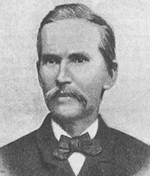Music and Texts of GARY BACHLUND Vocal Music | Piano | Organ | Chamber Music | Orchestral | Articles and Commentary | Poems and Stories | Miscellany | FAQs |
Between the Sunken Sun and the New Moon - (2006)
Paul Hamilton Haynefor medium high voice and piano
Between the sunken sun and the new moon,
I stood in fields through which a rivulet ran
With scarce perceptible motion, not a span
Of its smooth surface trembling to the tune
Of sunset breezes: “O delicious boon,”
I cried, “of quiet! wise is Nature’s plan,
Who, in her realm, as in the soul of man,
Alternates storm with calm, and the loud noon
With dewy evening’s soft and sacred lull:
Happy the heart that keeps its twilight hour,
And, in the depths of heavenly peace reclined,
Loves to commune with thoughts of tender power;
Thoughts that ascend, like angels beautiful,
A shining Jacob’s ladder of the mind.”
from An American Anthology, 1787–1900, Edmund Clarence Stedman, ed. (1833–1908)[ 4 pages, 3' 30" ]
Paul Hamilton Hayne
Paul Hamilton Hayne (1830-1886) was born in Charleston, South Carolina, on January 1st. He attended Charleston city schools and the College of Charleston, from which he graduated in 1852. He practiced law for a short time but abandoned the legal profession to pursue his literary interests.
Hayne served in the Confederate Army, beginning in 1861, as staff aide to Governor Pickens and remained in the Army until his health failed. Hayne lost all his possessions when Charleston was bombarded. Hayne, after the war, adopted Georgia as his home. Hayne published various collections of poems, including a complete edition in 1882, including romantic verse, long narrative poems, and ballads. Like so many of his fellow Southern poets, he was fond of nature and made it a subject of his poetry. He is sometimes referred to as the "Laureate of the South."
This gentle setting of Hayne's poem attempts to paint a chorale of the "soft and sacred lull" of which he speaks, keeping for a time thoughts of that "twilight hour." The simplicity of the setting aims to portray the "happy heart" after the storms of life which certainly this poet must have known all too well.
The notion of the happy man comes from the Psalms, as from Job from which we learn, " happy is the man whom God corrects." It is storms of life by which we see the hand of God correcting, and after each stormy correction there must come a moment of peace and reflection.
The score for Between the Sunken Sun and the New Moon is available as a free PDF download, though any major commercial performance or recording of the work is prohibited without prior arrangement with the composer. Click on the graphic below for this piano-vocal score.
Between the Sunken Sun and the New Moon

